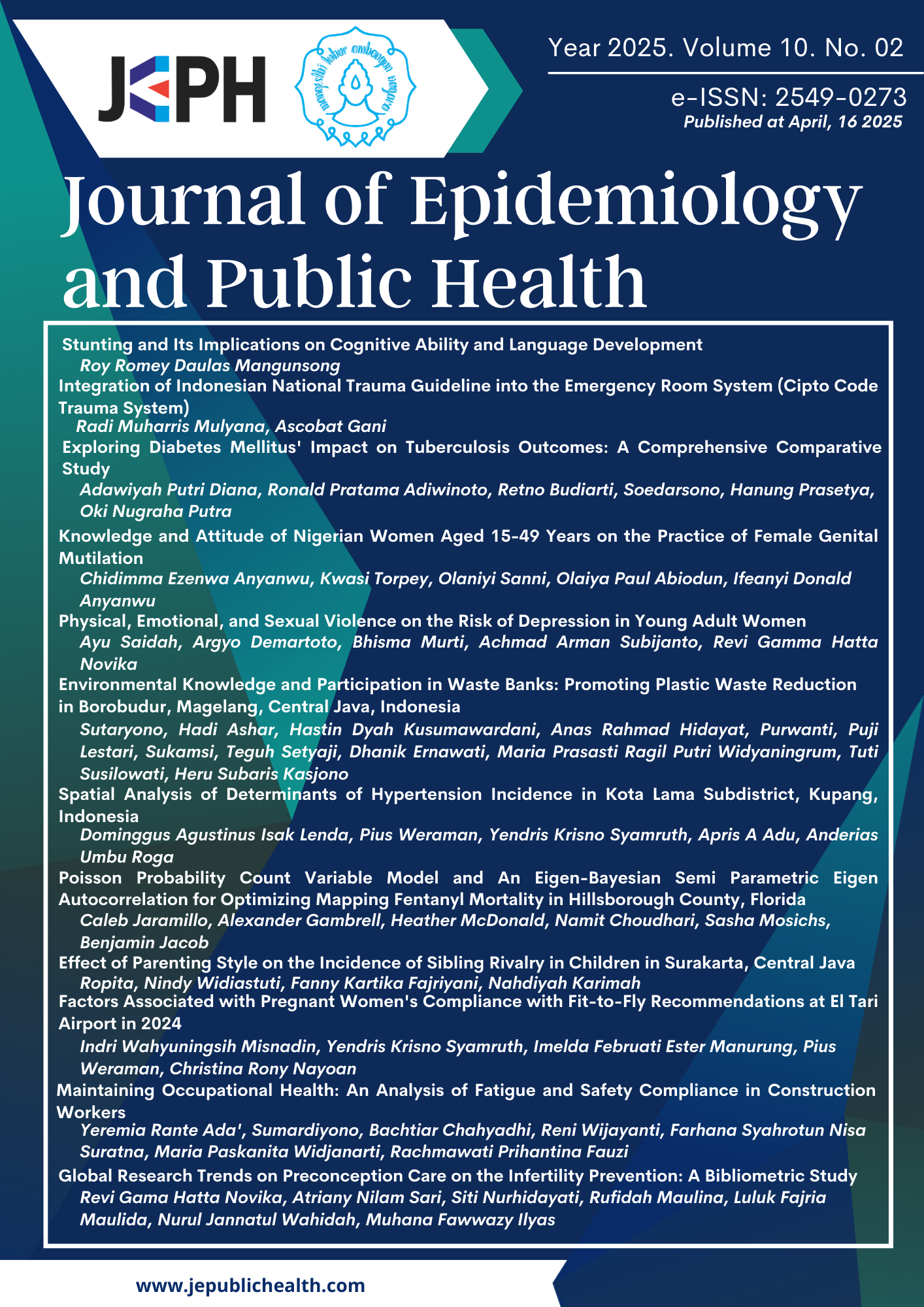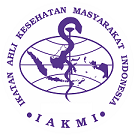Spatial Analysis of Determinants of Hypertension Incidence in Kota Lama Subdistrict, Kupang, Indonesia
DOI:
https://doi.org/10.26911/jepublichealth.2025.10.02.07Abstract
Background: Cardiovascular diseases such as hypertension, heart attack, and stroke are chronic non-communicable diseases influenced by genetic, physiological, environmental, and behavioral factors. Geographic Information Systems (GIS) can be utilized for spatial analysis to identify risk factors, distribution patterns, and determinants of diseases, including hypertension. This study aims to examine the determinants of hypertension using a spatial analysis approach in Kota Lama Subdistrict, Kupang City.
Subjects and Method: This study employed an ecological study design using an observational analytic method with a cross-sectional approach. The population consisted of residents aged ≥18 years in Kota Lama Subdistrict. A total of 400 individuals diagnosed with hypertension were selected using simple random sampling. The variables examined were age, overweight, lack of physical activity, high-salt diet, alcohol consumption, medication adherence, economic level, and distance to health facilities. Instruments used included a sphygmomanometer, microtoise, weight scale, and questionnaire. Spatial analysis was conducted using the GeoDa application with Regression, Bivariate Local Moran’s Index, Multivariate Local Geary, and Spatial Empirical Bayes tests.
Results: The results showed significant associations and clustered spatial autocorrelation with low-to-high relative risk (RR) observed in the subdistricts of LLBK, Bonipoi, Solor, Fatubesi, Oeba, Nefonaek, and Pasir Panjang for the variables: age (p=0.001, I=0.70), overweight (p<0.001, I=0.64), lack of physical activity (p=0.00, I=0.63), high-salt diet (p=0.00, I=0.63), and alcohol consumption (p<0.001, I=0.69). There were no significant associations for variables such as irregular medication intake, economic level, and distance to health facilities, with p-values of 1.000 > α (0.050).
Conclusion: Age, overweight, physical inactivity, high-salt diet, and alcohol consumption are significant determinants and show positive clustered spatial autocorrelation with hypertension. It is recommended that individuals over 40 years of age regularly monitor their blood pressure, maintain a healthy diet, engage in sufficient physical activity, and for those with hypertension, adhere to regular medication intake.
Keywords:
Hypertension, determinants, spatial analysis, autocorrelation, cluster, Kota LamaHow to Cite
References
Anselin L (2020). Geoda, an introduction to spatial data science local spatial autocorrelation (1) LISA and local Moran.
Grillo A, Salvi L, Coruzzi P, Salvi P, Parati G (2019). Sodium intake and hypertension. Nutrients, 11(9): 1–16. doi: 10.3390/nu11091970.
Hafni RP, Faridi A (2024). Hubungan konsumsi makanan berlemak, aktivitas fisik, dan kelebihan berat badan dengan hipertensi pada wanita usia subur di Bintang Metropol Bekasi. Indonesia J Health. 14(2): 96–100. doi: 10.33657/jurkessia.v14i2.920
Hartanto DP (2023). Stratified random sampling. Arena Statistic.
Isbandiyah, Mandiricha T, Rahmanda RA, Permadi FJ, Anugrah DF, Amalia R, Cahya LD (2024). Identifikasi faktor resiko hipertensi pada masyarakat pesisir pantai. CoMPHI J: Community Med Public Health Indonesia J. 4(3): 249–256. doi:10.37148/comphijournal.v4i3.189
Kemenkes (2021). Pedoman nasional pelayanan kedokteran tata laksana hipertensi dewasa. No. 4634.
Kementerian Kesehatan RI (2019). Laporan nasional Riskesdas 2018. Kementerian Kesehatan Republik Indonesia.
Kupang BK (2023). Kota Kupang dalam angka 2023. Kupang: BPS Kota Kupang.
Kusuma TA, Drajati ZA, Ningrum BP, Istiqomah II, Sidjabat FN (2024). Analisis spasial faktor risiko hipertensi dan diabetes mellitus berdasarkan screening PTM berbasis geographic information system (GIS) di wilayah kerja Puskesmas Pesantren II Kota Kediri. Askara J Kesehatan Komunitas. 1(1): 8–19.
Lukito AA, Kosasih A, Achmad A, Soenarta AA, Santoso A, Mumpuni SS, Widyantoro B, et al. (2016). Hipertensi dan obesitas. PERHI. 55.
Mantuges SHM, Widiany FL, Astuti AT (2021). Pola konsumsi makanan tinggi natrium, status gizi, dan tekanan darah pada pasien hipertensi di Puskesmas Mantok, Kabupaten Banggai, Sulawesi Tengah. Ilmu Gizi Indonesia. 4(2): 97–106.
Maziyya AA (2023). Pola penyakit tuberkulosis (TBC) di Provinsi Jawa Timur: Analisis spasial dan determinannya (Nasrudin M, ed.). 1st ed. Pekalongan: Penerbit NEM.
Mohi NY, Irwan I, Ahmad ZF (2023). Faktor-faktor yang berhubungan dengan kejadian hipertensi pada lansia di wilayah kerja Puskesmas
Wonggarasi I. J Health Sci: Gorontalo J Health Sci Community. 8(1): 1–13. doi:10.35971/gojhes.v8i1.21060.
Nubatonis PA, Riwu YR, Landi S (2024). Hubungan merokok, obesitas, konsumsi alkohol dan aktivitas fisik dengan kejadian hipertensi pada masyarakat yang berkunjung di Puskesmas Alak tahun 2021. SEHATMAS (J Ilmiah Kesehatan Masyarakat). 3(3): 522–530. doi:10.55123/sehatmas.v3i3.3856
Pradono J, Kusumawardani N, Rachmalina R (2020). Hipertensi: Pembunuh ter-selubung di Indonesia. Jakarta: Lembaga Penerbit Badan Peneliti dan Pengembangan Kesehatan.
Murti B (2013). Desain dan ukuran sampel untuk penelitian kuantitatif dan kualitatif di bidang kesehatan. Yogyakarta: Gadjah Mada University Press.
Qorina S, Birwin A, Alnur RD (2023). Determinan kejadian hipertensi di Puskesmas Kecamatan Tamansari Kota Jakarta Barat. J Medikes (Media Informasi Kesehatan). 10(1): 1–16.
Saragih M, Karimah I (2023). Faktor-faktor yang berpengaruh terhadap hipertensi pada dewasa muda. Jurnal Ners. 7(1): 573–577. doi: 10.31004/jn.v7i1.14077
Singh JN, Nguyen T, Kerndt CC, Damoon AS (2025). Physiology, blood pressure age related changes. In: National Library of Medicine. StatPearls.
Sofia A, Keraf L, Weraman P, Ndoen HI, Syamruth YK (2023). Faktor yang mempengaruhi kejadian demam ber-darah dengue berdasarkan model spasial di Kabupaten Sikka tahun 2019–2021. J Kesehatan Masyarakat. 13(3): 202–219.
WHO (2023). Hypertension. World Health Organization.



1.jpg)








